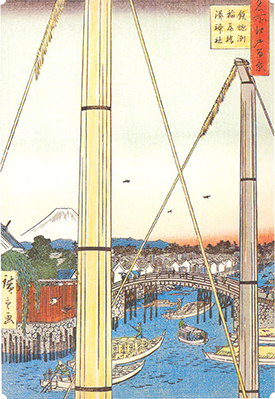
Research
4 September 2007
By Michelle Damian
One thing that has struck me about researching for the thesis and in thinking about researching for other archaeological projects has been the variety of sources that I have needed to pull together. Documents, oral histories, reconstructed and actual vessels, and of course the woodblock prints themselves have all been integral to this project - and that's not even considering a single archaeological site itself!
As I've mentioned before, visiting the various museums in Japan was incredibly helpful for understanding ship construction techniques that are impossible to see simply from the woodblock prints. The Jikuukan in Osaka houses a full-size reproduction of one of the wasen cargo ships. I had seen in several of the woodblock prints indications that the masts for these vessels were composite, with what appeared to be a number of smaller timbers lashed together to create the larger mast. At the Jikuukan, one exhibit showed the exact ways in which the mast timbers were joined together, showing the differences between the base of the mast, the central area, and the top configurations. Seeing the exhibit yielded greater information about the actual joinery techniques used in these composite masts.

The Minato-Jinja Shrine and Inaribashi Bridge at Teppozu, from Hiroshige's 100 views of Edo. Note the lashed masts of the vessels. (large view)
Perhaps the most enjoyable part of the research in Japan were the opportunities I had to conduct oral histories, particularly the chances I had to interview shipwrights about the techniques they use to build traditional watercraft even today. A former co-worker took me to visit Mr. Mitsumori Kanji, a shipwright from Hiroshima prefecture. Mitsumori-san (-san is a suffix meaning Mr. or Ms.) took an afternoon to show me the sasabune (“bamboo-leaf” boats, named for their resemblance to the slim leaves of that plant) and other boats he builds for use on the local rivers. He was very forthcoming with information about the uses of different kinds of fasteners, joinery techniques, and discussions of the ways the boats move in the water. My former co-worker received permission to take a video of Mitsumori-san as he showed us his tools and watercraft, and subsequently presented a copy of the video to the local museum as well. So few people still practice these techniques; it’s good to know that there is a permanent record of Mistumori-san’s explanations.
The resource that has been on my mind most for the past several weeks, however, has been documents. In preparation for beginning PhD studies in premodern Japanese maritime history/archaeology, I spent five weeks this summer in a kambun (classical Japanese) intensive workshop. Classical Japanese is quite different from modern Japanese, so this was quite a challenge for me. It is vital, however, for understanding contemporary documentation related to sites I will hopefully be working on someday. For final presentations in that class we chose a primary document related to our own research interests for translation and analysis. Although my thesis research is too “modern” for kambun documents, I still managed to find a maritime theme. I translated a short series of letters to and from a shogun (military leader) in 1342, discussing commissioning a boat to be built for dispatching on a trade mission to China – the first in ten years – to raise funds for constructing a temple in Kyoto. This brief document alone brought up so many questions for me. An international trade mission seems such a risky, time-consuming proposition with no guarantee of success; surely there must have been more reliable sources of funds for the temple. Why, then, did the shogun judge this the best way of getting a profit? There is an ambiguity in the translation that most likely indicates that the ship was commissioned to go to China, but could also be read as a Chinese-style ship. Perhaps someday an archaeological survey will help determine whether Chinese-style ships were being built in Japan. There was also no record in this document of the results of the mission – did the ship return successfully, or is it perhaps on the ocean floor, a future project waiting silently for an archaeological team? While these particular documents did not relate directly to my thesis research, I will be able to use this skill to read other documents related to my research. I can also easily see the potential to glean information about future research questions from similar materials.
I’ll be continuing to squeeze in thesis writing around my PhD coursework over the next few months. Progress may not be as speedy as I (or my thesis committee!) might hope, but I’ll be working as hard as I can!
As always please feel free to contact me at muaprojectjournal@yahoo.com with any comments, questions, or suggestions during the weeks to come. Yoroshiku onegai shimasu ("I look forward to your good favor").
Return to Project Journal home page.




